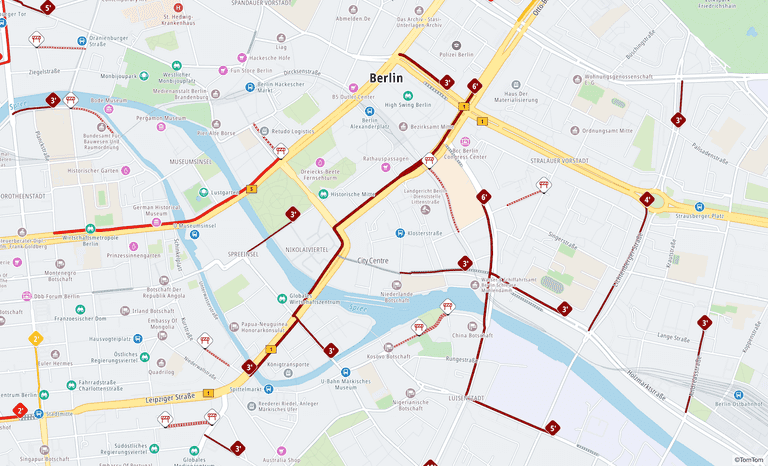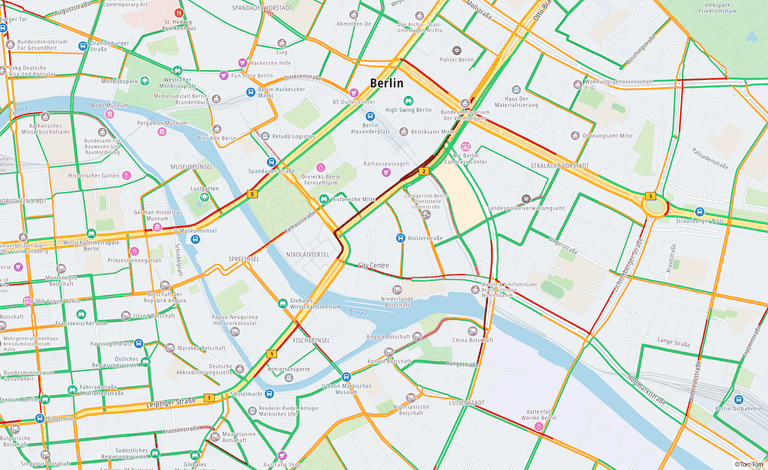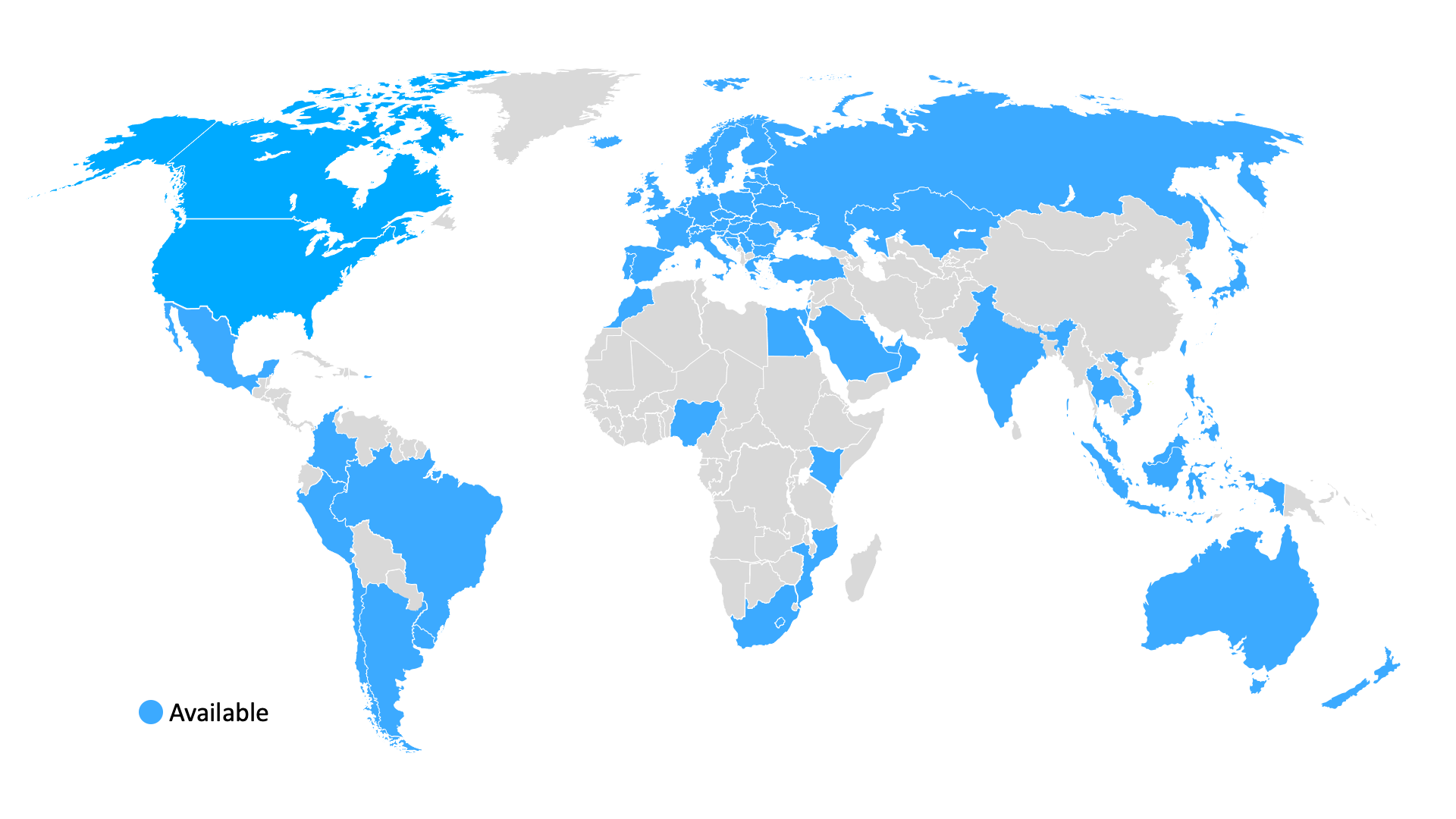Intermediate Traffic API - Introduction
Important notes:
- This TomTom Orbis API is in public preview.
- This API is powered by the TomTom Orbis Maps.
- See the TomTom Orbis Maps documentation for more information.
Purpose
The mission of TomTom is to help our customers arrive at their destinations faster, more safely, and more reliably, regardless of their locations. We developed TomTom Intermediate Traffic to deliver detailed, real-time traffic content to business customers who integrate it into their own applications.
Target customers for TomTom Intermediate Traffic include automotive OEMs, web and application developers, and governments. We deliver bulk traffic flow information that provides a comprehensive view of the entire road network.
TomTom delivered our first live traffic product in 2007 and our experience has taught us how to continue delivering the best traffic products in the market. Our real-time traffic products are created by merging multiple data sources, including anonymized measurement data from over 650 million GPS-enabled devices.
Using highly granular data, gathered on nearly every stretch of road, we can calculate travel times and speeds for virtually any day or time. We focus on our travel information so our customers can focus on their own business objectives.
What is the TomTom Intermediate Traffic API?
The TomTom Intermediate Traffic API enables business customers to download real-time TomTom traffic data for their server-based systems. Traffic data includes OSM IDs for location referencing to Orbis and OSM, GERS IDs for location referencing to Orbis as well as map-agnostic OpenLRs.
The data provided is:
- suitable for processing on the receiving end for online applications
- for delivery to client devices
- for analysis and display
Since customers are provided with direct access to the traffic data, they have control of more variables, such as the frequency rate at which the data is pulled from the server.
Product features & benefits
A detailed overview of the product features can be found on the data format specific documentation pages for each product. In the following topics, we list a few highlights and their benefits.
TomTom Traffic Incidents
The TomTom Traffic Incidents endpoint provides information on the current observed congestion and incidents on roads in all countries where we offer this service. Traffic 'incidents' in this context includes information like closed roads, lane closures, construction zones, and accidents.
Here is a selection of typical features and characteristics of the data:
- Updates every minute: This ensures access to the most up-to-date and accurate information.
- Global coverage: Provides access to real-time traffic information in many countries worldwide. See the Market Coverage page for a complete list.
- OpenLR & OSM way IDs & GERS IDs: Delivers flexibility and seamless coverage.
- Prediction: Improves route-planning for long trips; improves the estimated time of arrival.
- HOV Jams: Delivers speed information that can inform road authorities about how HOV lanes are used at different times of the day and days of the week.
- Turn-Dependent Jams: Provides more accurate information for routing.
 Figure 1: Rendering of TomTom Intermediate Traffic Incidents
Figure 1: Rendering of TomTom Intermediate Traffic Incidents
TomTom Traffic Flow Detailed
The TomTom Traffic Flow Detailed endpoint provide information on speed and travel times by road segment. It offers a high road coverage that also covers minor roads.
Here is a selection of typical features and characteristics of the data:
- Updates every minute: This ensures access to the most up-to-date and accurate information.
- Global coverage: Provides access to real-time traffic information in many countries worldwide. See the Market Coverage page for the complete list.
- OpenLR & OSM way IDs & GERS IDs: Delivers flexibility and seamless coverage.
- Prediction: Improves route-planning for long trips; improves the estimated time of arrival.
- HOV Flow: Delivers speed information that can inform road authorities about how HOV lanes are used at different times of the day and days of the week.
For a complete list of individual features and their support by flavor and data format, see the FAQ.
 Figure 2: Rendering of TomTom Intermediate Traffic Flow
Figure 2: Rendering of TomTom Intermediate Traffic Flow
Available feeds and formats
Our traffic and speed limit information is provided in different data formats:
- DATEX II is an industry standard for information exchange between service providers, application developers, and traffic management centers. The data format is XML based. More information is at http://www.datex2.eu.
- Protobuf is a method for encoding structured data in an efficient yet extendable format. See http://code.google.com/p/protobuf for more information.
In the following table we explain which endpoint can be used with which formats, and we link to the corresponding documentation pages.
| Product | Format-specific documentation |
|---|---|
| TomTom Intermediate Traffic Incidents | |
| TomTom Intermediate Traffic Flow Detailed |
Use cases
TomTom Intermediate Traffic has the following common use cases:
- Navigation and mobile applications: current and predicted speed, and delay information enables better route calculations and more accurate ETAs. These help drivers save time, fuel, and money.
- Navigation and mobility applications: real-time content enables the creation of a visual layer of live traffic congestion and events that can be displayed on a map or navigation application.
- Fleet, Logistics and On-Demand services: routing drivers around traffic incidents enables more accurate ETAs and improves customer service.
- Traffic management: real-time traffic insights enable road authorities, highway agencies, and traffic management centers to monitor traffic with an accurate, detailed view of average speeds and incidents across the entire road network.
A secure connection
TomTom Intermediate Traffic is a secure API that uses an API Key in combination with a client certificate. The process to request a certificate for your API Key is described in the Authentication page.
Alternatively, customers accessing the API can also connect from a (set of) fixed IP address(es) that were previously assigned to the API Key. The recommended way, however, is access via client certificate, since there is no restriction to a specific IP address when using a certificate.
Coverage
TomTom is continually expanding the geographic coverage of our real-time traffic. For the most recent information, contact your TomTom account manager. We offer real-time traffic information via the TomTom Intermediate Traffic API in the countries shown in the following map image:
 Figure 3: Global coverage of TomTom Intermediate Traffic
Figure 3: Global coverage of TomTom Intermediate Traffic
For a complete list of countries supported by the TomTom Intermediate Traffic API product, see the Market Coverage page.